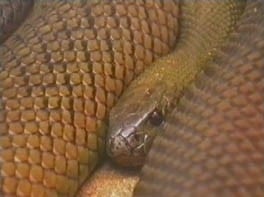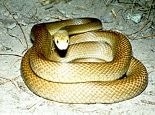-
King Brown or Mulga Snake
Scientific Name: Pseudechis australis Despite its common name, the king brown snake is not a true brown snake but one of the black snake family. A bite from this snake would therefore be treated with black snake antivenom. As with many Australian snakes the colour is variable. Most specimens are mid-brown, some with a coppery […]
Continue reading -
Fierce Snake (Inland Taipan)
Scientific Name: Oxyuranus microlepidotus The fierce snake or inland taipan can reach a total length of 2.5 metres, although 1.8 metres is the more usual length. The upper surface of the snake can vary from dark brown to a light straw colour. Dramatic seasonal colour changes take place, with a darker winter and lighter summer […]
Continue reading -
Eastern Brown Snake
Scientific Name: Pseudonaja textilis The eastern brown snake is the species responsible for most deaths caused by snakebite in Australia, although, with the advent of efficient first-aid treatment and antivenom, there are now usually only one or two deaths per year. A large adult brown snake is a formidable creature. They may exceed two metres […]
Continue reading -
Common Death Adder
Scientific Name: Acanthophis antarcticus Death adders are easily distinguishable from other snakes by the very short, squat bodies, rapidly tapering tail and the broad triangular head. Colouration varies widely but most species exhibit some form of banded pattern in shades of brown or grey. The tail tip is usually a different colour to the rest […]
Continue reading -
Coastal taipan
Scientific Name: Oxyuranus scutellatus Australia’s deadliest snake also has huge fangs, which grow up to 12 millimetres long! It uses these to inject a powerful venom into the body. The coastal taipan is commonly about 1.5-2 metres long, but can grow to 3m. Sporting a slender light to dark brown body, and a cream/yellow belly […]
Continue reading -
Brown Tree Snake
Scientific Name: Boiga irregularis The brown tree snake is very distinctive because of its large head with bulging eyes and its long slender body. Lengths in excess of 2 metres have been recorded, though 1.5-1.8 metres is a more common size. The colouration is usually a medium brown background with a series of darker markings […]
Continue reading -
Woma python
Scientific Name: Aspidites ramsayi The woma python has ‘wow!’ factor with its distinctive banded patterning of alternating light and dark browns. The browns range in colour from yellowish, reddish to olive-brown and grey. Sometimes the banding can be faint, and other times mottled. The underbelly is creamy yellow. It has a very narrow pointed tail, […]
Continue reading -
Stimson Python
Scientific Name: Antaresia stimsoni The Stimson python, which is sometimes known as the large-blotched python, has a pattern of golden to red-brown or chocolate-brown patches on a light tan to yellow background. The python is non-venomous, and kills its prey by coiling around it so that it can’t breathe. One of the smaller pythons, they […]
Continue reading -
Spotted Python
Scientific Name: Antaresia maculosa The spotted python is one of the shortest python species, growing to only a metre. Its ‘spots’ are really blotches of dark brown on a light brown background. Sometimes the spots join together so they look almost like stripes, especially near the head and tail. Due to their short length, lack […]
Continue reading -
Rough-scaled Python
Scientific Name: Morelia carinata Probably the rarest snake in Australia, the rough-scaled python is only known from around ten snakes captured in the wild. The general colour is dark brown with pale brown blotches. Towards the tail the pale blotches become larger so that the pattern appears to be reversed with a pale background and […]
Continue reading










